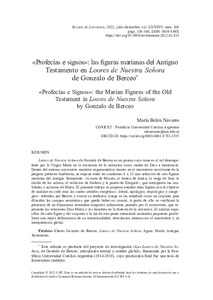Por favor, use este identificador para citar o enlazar este ítem:
https://repositorio.uca.edu.ar/handle/123456789/16060| Título: | Profecías e signos: las figuras marianas del Antiguo Testamento en Loores de Nuestra Señora de Gonzalo de Berceo Profecías e Signos: the Marian figures of the Old Testament in Loores de Nuestra Señora by Gonzalo de Berceo |
Autor: | Navarro, María Belén | Palabras clave: | Gonzalo de Berceo, ca1195-ca1265; ANTIGUO TESTAMENTO; LITERATURA ESPAÑOLA; LITERATURA MEDIEVAL; ANALISIS DEL DISCURSO; VIRGEN MARIA | Fecha de publicación: | 2022 | Editorial: | Consejo Superior de Investigaciones Científicas. Servicio de Publicaciones | Cita: | Navarro, M. B. Profecías e signos: las figuras marianas del Antiguo Testamento en Loores de Nuestra Señora de Gonzalo de Berceo [en línea]. Revista de Literatura. 2022, 84 (168). doi: 10.3989/revliteratura.2022.02.013. Disponible en: https://repositorio.uca.edu.ar/handle/123456789/16060 | Proyecto: | Los Loores de Nuestra Señora, de Gonzalo de Berceo: articulación textual y sentido global | Resumen: | Resumen: Loores de Nuestra Señora de Gonzalo de Berceo es un poema cuyo tema es el rol desempeñado por la Virgen María en la economía de la salvación como madre de Dios e intercesora.
Dentro del extenso microtexto narrativo-argumentativo inserto en el macrotexto envolvente de la
plegaria petitorio-laudatoria, se expone entre las cuadernas 4 a 13 una selección de seis figuras
marianas del Antiguo Testamento –la mata de Moisés, el bastón de Aarón, la verga de Jesé, la
alcoba de los salmos, el vellocino de Gedeón y la puerta de Ezequiel–, que anticiparon las cualidades y acciones de María. El presente trabajo se propone estudiar tales figuras con el objetivo
de analizar en cada caso los cuatro sentidos exegéticos –literal, tipológico, tropológico y anagógico– referidos por Berceo y evocar su tradición. Luego se las estudiará como un conjunto para
dilucidar los campos semánticos que pueda haber en común. A partir de ello se verificará la
presencia de un dinamismo semántico-alegórico subyacente, pautado por el macrotexto, que representa las relaciones Dios-María y los hombres en la historia de la salvación. El análisis específico de cada figura y del conjunto a la luz de esta pauta estructural-semántica propuesta posibilitará una mejor delimitación de su intencionalidad, articulación interna con el macrotexto y su
interpretación global. Abstract: Loores de Nuestra Señora by Gonzalo de Berceo is a poem whose topic is the role played by Virgin Mary in the economy of Salvation as the mother of God and intercessor. Within the narrative-argumentative microtext inserted into the macrotextual petition-laudatory prayer, there are six Marian figures of Old Testament between the stanzas 4-13 –the burning bush, the Aaron’s staff, the branch from Jesse, the chamber of the psalms, the Gideon’s fleece and the door of Ezekiel–, which predicted her qualities and actions. This paper aims to analyse the four exegetical senses –literal, typological, tropological and anagogical– referred by Berceo in each figure and to evoke their tradition. Subsequently they will be examined as a set to expose the semantic fields that they may share. As a result, the presence of an underlying semantic-allegorical dynamism will be verified and it will signify the relationship between God, Mary and men in the history of Salvation. The specific analysis of the figures and the set considering this proposed structural-semantic pattern will enable a better definition of their intention, internal coordination with the macrotext and interpretation. |
URI: | https://repositorio.uca.edu.ar/handle/123456789/16060 | ISSN: | 0034-849X (online) | Disciplina: | LITERATURA | DOI: | 10.3989/revliteratura.2022.02.013 | Derechos: | Acceso abierto | Fuente: | Revista de Literatura Vol. 84, No.168, 2022 |
| Aparece en las colecciones: | Artículos |
Ficheros en este ítem:
| Fichero | Descripción | Tamaño | Formato | |
|---|---|---|---|---|
| profecías-signos-figuras.pdf | 332,91 kB | Adobe PDF |  Visualizar/Abrir |
Visualizaciones de página(s)
72
comprobado en 27-abr-2024
Descarga(s)
77
comprobado en 27-abr-2024
Google ScholarTM
Ver en Google Scholar
Altmetric
Altmetric
Este ítem está sujeto a una Licencia Creative Commons

